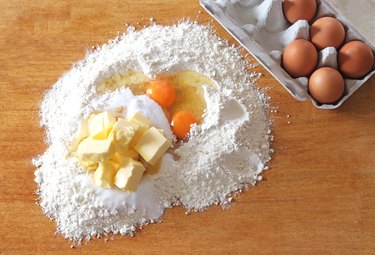
All-purpose flour and eggs are some of the most popular food binders. Their role is to improve and maintain food texture. If you're sensitive to gluten or eggs, there are many other binding agents you can use to enhance the flavor and nutritional value of homemade meals.
Tip
Binders are used with other ingredients to maintain food texture and shape. Even though all-purpose white flour and eggs are the most popular options, you can use many other foods that provide more nutrition and flavor.
Video of the Day
Popular Binding Agents
From cookies to meat products like salmon cakes, food binders are added to other ingredients to help food with its texture, shape and moistness. They can also add some flavor and nutrients to your meals and snacks.
Video of the Day
The USDA has a long list of binding agents, so keep it at hand. Some of the most popular and widely used food binders are the following:
- Eggs
- Wheat flour
- Cracker crumbs
- Oatmeal
- Rice
- Milk
- Evaporated milk
- Gelatin
- Guar gum
- Xanthan gum
- Psyllium husk
- Potato starch
- Ground flax
- Tapioca
Food binders run the gamut from dairy products to fruits and even vegetables. You are familiar with many of them, such as milk, oatmeal and cracker crumbs, but some are not widely used in home cooking. For example, guar gum is made from legumes, while xanthan gum is a white powder produced from fermented sugar. The FDA lists both of these as "safe and suitable" food binders and they are found in a wide range of products.
Psyllium is a form of fiber made from the husks of a plant and can be purchased in powder or supplement form. Metamucil, for instance, contains this ingredient. Rich in fiber, psyllium husk is a great binding agent as it may help lower cholesterol levels, points out Berkeley Wellness. When ingested in large amounts, it may affect nutrient absorption, but a small dose (one teaspoon) is unlikely to have side effects. One teaspoon can be substituted for one egg in recipes.
Best Binding Flours
White flour is one of the most popular binding agents as it's used in everything from muffins to cookies and cakes. The Cleveland Clinic states that white flour provides few nutrients as it contains no fiber, protein or healthy fats. But several other types of flour will help bind foods while also giving them a nutritional kick.
One great choice for baking is almond flour. A January 2015 study published in the_ Journal of the American Heart Association_ and funded by the Almond Board of California reports that almonds may reduce the bad LDL cholesterol and protect against cardiometabolic disorders. Plus, almond flour is gluten-free (unless it was produced in a facility that handles wheat). The next time you're making muffins, consider swapping white flour for almond flour.
The Cleveland Clinic reports that coconut flour is another great binding agent as it contains lots of fiber, healthy fats and digestible carbohydrates. The only thing to be aware of is that you may need to add more liquids, such as oil or water, when baking with this ingredient. If you have nut allergies, coconut flour is a good choice.
Oat flour consists of ground-up rolled oats, making it ideal for those trying to cut out refined carbs, such as those in white flour. Simply place rolled oats in your food processor and grind until you obtain a fine powder. Note that oat flour is higher in fiber and protein compared to all-purpose flour, so it can easily fit into a balanced meal plan.
If you're on a gluten-free diet, you may opt for gluten-free all-purpose flour or make your own using gluten-free rolled oats.
Read More: Baking With Almond, Rice and Coconut Flour
Egg-Free Food Binder Substitutes
Eggs are another popular food binding agent because they not only bind the mixture together but also help the dough rise. Keep in mind that egg substitutes may alter the density or the taste of your finished product.
The Asthma and Allergy Foundation of America recommends the following replacements for one egg:
- 1/2 of a medium mashed banana
- 1/4 cup of purees fruits, such as applesauce
- 3.5 tablespoons of a gelatin blend
- 1 tablespoon of ground flaxseed mixed with 3 tablespoons warm water
Commercial egg substitutes can also be used, but they do contain eggs, so keep that in mind if you're allergic to this food. Xanthan gum is another egg substitute and requires just one teaspoon to replace one egg.
To get more heart-healthy fats in your diet, swap eggs for avocados in your recipes. Use a quarter cup of this fruit for each egg. This works best in recipes like brownies, where the color is already dark.
- USDA: "Table of Safe and Suitable Ingredients: Binders Update"
- Berkeley Wellness: "Psyllium and Nutrient Absorption"
- The Cleveland Clinic: "How to Use Healthy Flour Substitutes – Or Have Your Cake and Eat It Too"
- Journal of the American Heart Association: " Effects of Daily Almond Consumption on Cardiometabolic Risk and Abdominal Adiposity in Healthy Adults With Elevated LDL‐Cholesterol: A Randomized Controlled Trial"
- The Asthma and Allergy Foundation of America A Division of the Kids With Food Allergies: "Cooking and Baking without Egg Ingredients"